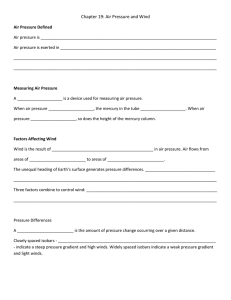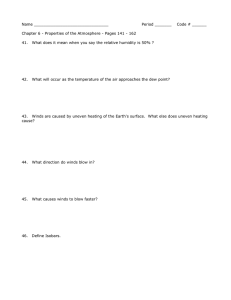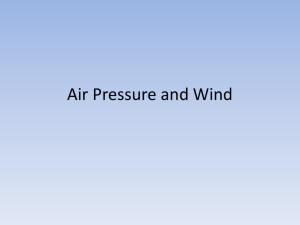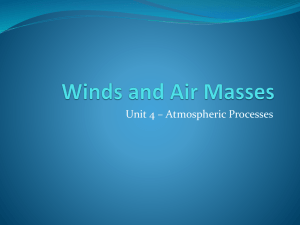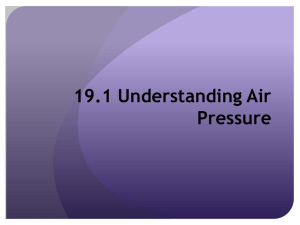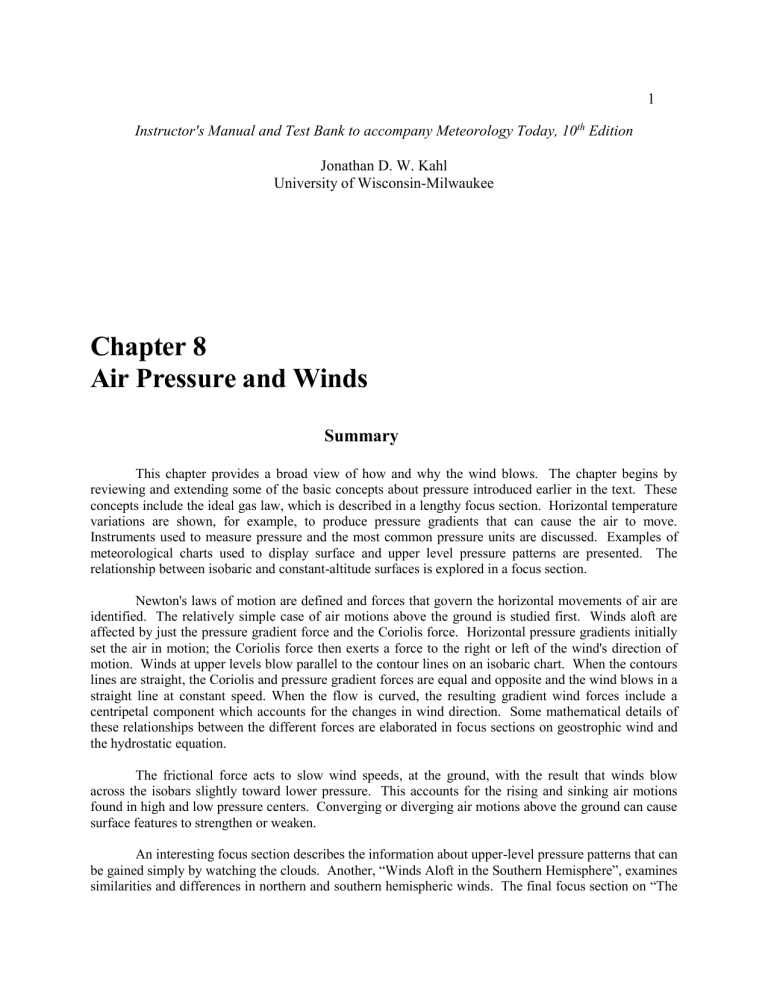
1 Instructor's Manual and Test Bank to accompany Meteorology Today, 10th Edition Jonathan D. W. Kahl University of Wisconsin-Milwaukee Chapter 8 Air Pressure and Winds Summary This chapter provides a broad view of how and why the wind blows. The chapter begins by reviewing and extending some of the basic concepts about pressure introduced earlier in the text. These concepts include the ideal gas law, which is described in a lengthy focus section. Horizontal temperature variations are shown, for example, to produce pressure gradients that can cause the air to move. Instruments used to measure pressure and the most common pressure units are discussed. Examples of meteorological charts used to display surface and upper level pressure patterns are presented. The relationship between isobaric and constant-altitude surfaces is explored in a focus section. Newton's laws of motion are defined and forces that govern the horizontal movements of air are identified. The relatively simple case of air motions above the ground is studied first. Winds aloft are affected by just the pressure gradient force and the Coriolis force. Horizontal pressure gradients initially set the air in motion; the Coriolis force then exerts a force to the right or left of the wind's direction of motion. Winds at upper levels blow parallel to the contour lines on an isobaric chart. When the contours lines are straight, the Coriolis and pressure gradient forces are equal and opposite and the wind blows in a straight line at constant speed. When the flow is curved, the resulting gradient wind forces include a centripetal component which accounts for the changes in wind direction. Some mathematical details of these relationships between the different forces are elaborated in focus sections on geostrophic wind and the hydrostatic equation. The frictional force acts to slow wind speeds, at the ground, with the result that winds blow across the isobars slightly toward lower pressure. This accounts for the rising and sinking air motions found in high and low pressure centers. Converging or diverging air motions above the ground can cause surface features to strengthen or weaken. An interesting focus section describes the information about upper-level pressure patterns that can be gained simply by watching the clouds. Another, “Winds Aloft in the Southern Hemisphere”, examines similarities and differences in northern and southern hemispheric winds. The final focus section on “The 2 Hydrostatic Equation” describes the equilibrium that exists between the downward gravitational and upward pressure-gradient forces, and how this equilibrium can be used to determine air pressure aloft. Teaching Suggestions 1. A one-inch-square iron bar cut approximately 53 inches long weighs 14.7 pounds. When placed on end, the pressure at its base will be 14.7 pounds/sq. in., the same as that of the atmosphere at sea level. The bar can be passed around class and the students will be surprised at how heavy it is. The bar can be used to motivate a discussion of the concept of density and the workings of the mercury barometer. If the bar were constructed of mercury, it would only need to be 30 inches long. If the bar were made of water, it would need to be close to 34 feet tall. Students should understand also why they are not crushed by the weight of many "iron bars" pressing in on every square inch of their bodies. One misconception that the bar might create is that pressure exerts only a downward force. The next demonstration might help clear that up. 2. There are a variety of "crushed-can" demonstrations. For example, put a small amount of water into a clean, metal can. Heat the can until the water boils and then tightly seal the spout. The can will be crushed by the weight of the atmosphere as it cools. The water is not necessary, but it enhances the effect. Use the ideal gas law to explain the pressure imbalance that was created. 3. Show students a surface weather map without any isobars drawn on it. The students will appreciate how difficult it is to assimilate the large quantity of data plotted on the map. It will not be apparent at all what large scale weather features are present nor what is causing the observed weather conditions. Then, show the students the same map with a completed isobaric analysis. The positions of important high and low pressure centers will become clear immediately and their effect on the weather conditions in their vicinity will be apparent. 4. Any discussion of the Coriolis force will lead to a question about whether the direction water spins when draining out of a sink or toilet bowl is different in the Southern Hemisphere than it is in the Northern Hemisphere. The instructor can demonstrate that water can be made to rotate in either direction when draining from a plastic soft drink bottle. 5. Demonstrate the difference between pressure and force by having a student lean on another student using his/her open palm, then repeating the process using only a fingertip. Same force, different pressures. 6. Demonstrate the pressure gradient force by inflating a balloon and having a student pop it with a pin. Discuss the direction of the resulting air flow and the relationship between force and gradient. 7. Bring a barometer to class. Compare the measured pressure with the official pressure measurement at a nearby National Weather Service measurement station. Discuss reasons for the difference in pressure readings. 8. Examine sea-level pressures and winds on a surface weather map and discuss the relationship between wind and pressure gradients. 9. Introduce the concept of a frame of reference by standing in the middle of the classroom (amidst 3 the students) and waving one hand in a circular motion. Ask the students in front of you to describe the direction of rotation. Ask the students behind you the same question. Challenge the students to determine which answer is correct. Relate the discussion to the Coriolis force. 10. When beginning the topic of hydrostatic equilibrium, ask students to compare the vertical pressure gradient in the lowest 10 km of the atmosphere with the horizontal pressure gradient somewhere on the weather map. Ask students to speculate on the strength of the vertical wind such a large pressure gradient would produce. Student Projects 1. Give the students a simplified surface weather chart and have them perform an isobaric analysis. Initially, to keep the map as simple as possible, it might be best to plot only the wind and pressure data. Once students have located centers of high and low pressure, have them transfer the positions to a second map with additional data (temperature, cloud cover, weather, dew point). Have students circle regions with overcast skies or stations that are reporting precipitation. Are the stormy regions associated with high or low pressure? 2. Have students plot daily average pressure and observed weather condition for several weeks. Are stormy periods well correlated with lower-than-average pressures? 3. Determine the direction of upper-level winds by observing mid-level cloud motions. Have students draw the orientation of contour lines that would produce the observed motion and then compare their sketch with an actual upper-air chart. 4. Have students obtain examples of weather reports and weather maps from other countries. Students should attempt to find at least one example from a city in the Southern Hemisphere. A resource for this is the World Meteorological Organization website: http://www.wmo.int/pages/members/index_en.html 5. Have students explain why, in the northern hemisphere, an airplane’s deviation is always to the right of its motion, regardless of the direction the plane is traveling. Answers to Questions for Review 1. In the colder, denser air, the pressure decreases rapidly with height because you climb above large numbers of molecules as you increase your altitude. 2. It takes a shorter column of cold, more-dense air to exert the same surface pressure as a taller column of warm, less-dense air. 3. 1013.25 mb or 29.92 in. Hg or 1013.25 hPa. 4. An aneroid barometer houses a small, flexible metal box called an aneroid cell. Before the cell is tightly sealed, air is partially removed, so that small changes in external air pressure cause the cell to expand or contract. A mercury barometer consists of a long glass tube open at one end and closed at the 4 other. Removing air from the tube and covering the open end, the lower portion of the tube is immersed into a dish of mercury. The column of mercury in the tube balances the weight of the air above the dish, and hence the height of the column is a measure of atmospheric pressure. 5. Station pressure is the atmospheric pressure at the elevation of the weather station. Sea-level pressure is the station pressure the weather station would have if the station were located at sea level. The two would be the same if the station were located at sea level. 6. Cold air aloft: low pressure. Warm air aloft: high pressure. 7. Newton’s first law of motion states that an object at rest will remain at rest and an object in motion will remain in motion (and travel at a constant velocity along a straight line) as long as no force is exerted on the object. So, to start air moving, to speed it up, to slow it down, or even to change its direction requires the action of an external force. Newton’s second law states that the force exerted on an object equals its mass times the acceleration produced. From this relationship we can see that, when the mass of an object is constant, the force acting on the object is directly related to the acceleration that is produced. 8. Because temperatures tend to decrease as you go northward (in the northern hemisphere). 9. Pressure-gradient force. 10. (a) Deflects it to the right. (b) Deflects it to the left. 11. (a) Causes the Coriolis force. (b) Increases it. (c) Increasing latitude increases the Coriolis force. 12. Many isobars drawn closely together. 13. Closely-spaced isobars indicate a strong pressure gradient, and strong pressure gradients cause strong winds. 14. A geostrophic wind is a wind that results from a balance between the Coriolis force and the pressure gradient force. At the equator there is no Coriolis force, thus there cannot be a geostrophic wind. 15. Because winds at these altitudes are approximately geostrophic, with higher pressures (warmer temperatures) to the south and lower pressures (colder temperatures) to the north. 16. In the Northern Hemisphere: Highs have a clockwise circulation aloft, lows have a counterclockwise circulation aloft. At the surface, the direction of the circulation is the same as aloft but the winds tend to cross the isobars toward lower pressures. In the southern hemisphere: Highs have a counterclockwise circulation aloft, lows have a clockwise circulation aloft. At the surface, the direction of the circulation is the same as aloft but the winds tend to cross the isobars toward lower pressures. 17. Pressure-gradient force, Coriolis force, friction, centripetal force. 18. The roughness of the terrain. 5 19. Zonal flow is along a latitude belt: either west-to-east or east-to-west. Meridional flow is along a line of longitude: either south-to-north or north-to-south. 20. Highs: descending air. Lows: ascending air. 21. Because of hydrostatic balance: the downward force of gravity balances the upward vertical pressure gradient force. 22. In the Northern Hemisphere, if we stand with the wind aloft to our backs, lower pressure will be to our left and higher pressure to our right. 23. Surface friction reduces wind speed, and changes the direction by causing the wind to cross the isobars toward lower pressure at an angle of approximately 30 degrees. 24. In the Northern Hemisphere, air flows first southward and then northward in a trough. Temperatures tend to be cold. In a ridge, air first flows northward and then southward. Temperatures tend to be high. Answers to Questions for Thought 1. Assuming no corrections are made for altitude, the drop in pressure from the base to the top of the hill would be detected by the barometer; the reading could be lower than that observed in most storms. 2. Inside the refrigerator, the temperature of the air inside the balloon will decrease. The Gas Law requires that the air pressure inside the balloon must also decrease. (The air density inside the balloon will also increase slightly.) When removed from the refrigerator the air temperature inside the balloon will increase. According to the Gas Law, when air temperature increases then air pressure must also increase, thus inflating the balloon. 3. Air column T will have the highest surface pressure (dry air weighs more than moist air at the same temperature). 4. Sure, if the station was located below sea-level. California.) (One example would be Death Valley, 5. Higher pressures aloft are to the northwest, lower pressures are to the southeast. Since there is a significant north-south component to the upper-level air flow, the flow is meridional. 6. High pressures and high temperatures are associated with high heights on an isobaric surface, while low pressures and low temperatures are associated with low heights. When flying from high pressure and warm air into a region of low pressure and cold air, without changing the altimeter setting, the altimeter (which measures pressure and indicates altitude) will indicate an altitude higher than the aircraft is flying. Because the aircraft is flying lower than indicated, it is wise to look out below for obstructions such as mountains and hills. 7. The altimeter will continue to indicate the same altitude because it measures pressure. The 6 constant pressure surface will be located at higher than standard altitude in the warmer air because pressure decreases more slowly in warm air than in cooler air. Once it enters the warm air, the aircraft will actually be flying at a higher altitude than that indicated by the altimeter. 8. The wind would blow directly from regions of higher pressure toward regions of lower pressure. 9. The frictional effect of the water is less. Consequently, with the same PGF the winds are stronger, the Coriolis force is stronger, and the winds blow more nearly parallel to the isobars. 10. Assuming that this flow is in the Northern Hemisphere, the flow would be cyclonic (low pressure center). The relative magnitude of the centripetal force would be the difference between the PGF and Coriolis force. The centripetal force would be directed inward. 12. The surface wind would probably be either south or southeast. If the upper-level low is an elongated trough of low pressure, then the winds overhead would probably be more southwesterly, and the middle-level clouds would be moving from southwest to northeast. The wind is changing in a clockwise direction with increasing height, this is veering. The winds aloft would be stronger than the surface winds. 13. By illustrating the wind flow patterns around a high pressure area and moving the high from west to east, north of your location. 14. On a frictionless surface the winds around a surface low would blow parallel to curved isobars with the PGF directed inward and the Coriolis force directed outward. However, frictions slows the wind, which reduces the Coriolis force. Because of the stronger PGF, the winds blow inward across the isobars toward lower pressure, giving the appearance that the winds are being deflected to the left. The inwardlydirected force is stronger. 15. On the equator the Coriolis force is zero. Because there is no deflecting force the wind can blow either clockwise or counterclockwise around an area of low pressure, depending upon how the flow initially responds to the PGF. In either case, the PGF supplies the inwardly-directed force needed for circular motion. This would be an example of cyclostrophic flow. 16. Inside the closed car the air density remains constant, however, the temperature increases. In this case the gas law ( P = T x constant) dictates that an increase in temperature will produce an increase in pressure. If the car is air tight, the pressure inside could become great enough to crack or "blow out" a window. 17. The wind speed will increase due to reduced friction over the lake. The wind direction will veer (turn in a clockwise direction) as a result of the increased Coriolis force. 18. The magnitude of the Coriolis force is very small close to the equator. Also, the slope of the tub basin is a much more important factor in determining the direction of rotation. Answers to Critical Thinking Questions Figure 8.21. To the left. To a person not on the platform the ball would appear to move in a straight 7 line. Figure 8.23. The aircraft paths would look like the arrows drawn on part (a) of the figure. 8 Multiple Choice Exam Questions 1. Net convergence of air would cause surface pressure to ____ and net divergence would cause surface pressure to ____. a. increase, decrease b. increase, increase c. decrease, decrease d. decrease, increase ANSWER: A 2. If the earth's gravitational force were to increase, atmospheric pressure at the ground would a. increase. b. decrease. c. remain the same. d. cause the atmosphere to expand vertically. ANSWER: A 3. The surface pressures at the bases of warm and cold columns of air are equal. Which of the following statements is not correct? a. Pressure will decrease with increasing height at the same rate in both columns. b. The cold air is denser than the warm air. c. Both columns of air contain the same total number of air molecules. d. The weight of each column of air is the same. ANSWER: A 4. The surface pressures at the bases of warm and cold columns of air are equal. Air pressure in the warm column of air will ____ with increasing height ____ than in the cold column. a. decrease, more rapidly b. decrease, more slowly c. increase, more rapidly d. increase, more slowly ANSWER: B 5. Suppose a parcel of air has a given temperature, pressure, and density. If the parcel's size remains the same while its temperature increases, then the air pressure inside the parcel will a. decrease. b. decrease to but not lower than 1,000 mb. c. increase. d. remain constant. ANSWER: C 6. Suppose a very cold parcel of air at 5.5 km (18,000 feet) is compared to a similar (but warm) parcel of air at sea level. Which of the following would be true? a. The parcel at sea level has higher pressure and higher density. b. The parcel at sea level has lower pressure and higher density. 9 c. The parcel at sea level has lower pressure and lower density. d. The parcel at sea level has higher pressure and lower density. ANSWER: A 7. If two air parcels at sea level have the same size but different temperatures, the colder parcel of air will have a. a higher pressure but the same density as the warm parcel. b. the same pressure but lower density than the warm parcel. c. the same pressure but higher density than the warm parcel. d. a lower pressure but the same density as the warm parcel. ANSWER: C 8. Which of the following relationships best describes the gas law? a. Pressure is proportional to density times temperature. b. Density is proportional to pressure times temperature. c. Temperature is proportional to density times pressure. d. Temperature times pressure times density remains constant. ANSWER: A 9. The scale on an altimeter indicates altitude, but an altimeter actually measures a. temperature. b. density. c. pressure. d. humidity. ANSWER: C 10. The unit of pressure most commonly found on a surface weather map is a. inches of mercury. b. millibars or hectopascals. c. pounds per square inch. d. atmospheres. ANSWER: B 11. Which of the following instruments measures pressure? a. barometer b. thermometer c. radiometer d. hygrometer e. densitometer ANSWER: A 12. A station at an altitude of 900 m (about 3,000 feet) above sea level measures an air pressure of 930 mb. Under normal conditions, which of the values below do you think would be the most realistic sea level pressure for this station? a. 840 mb 10 b. 930 mb c. 1,020 mb d. 1,830 mb ANSWER: C 13. To correctly monitor horizontal changes in air pressure, the most important correction for a mercury barometer is the correction for a. temperature. b. altitude. c. density. d. gravity. ANSWER: B 14. Lines connecting points of equal pressure are called a. isobars. b. millibars. c. contours. d. isotherms. e. a coordinate grid. ANSWER: A 15. Pressure changes a. more rapidly in the horizontal direction than in the vertical. b. more rapidly in the vertical direction than in the horizontal. c. at the same rate in the horizontal and vertical directions. d. more rapidly in the vertical over land than over the ocean. ANSWER: B 16. On an isobaric surface, a. altitude is constant. b. temperature is constant. c. pressure is constant. d. a and c ANSWER: C 17. Low ____ on a constant height chart corresponds to low ____ on a constant pressure chart. a. pressures, pressures b. pressures, heights c. heights, pressures d. heights, heights ANSWER: B 18. On a 500 millibar chart, ____ are drawn to represent horizontal changes in altitude which correspond to horizontal changes in pressure. a. contour lines 11 b. isobars c. isotherms d. isotachs ANSWER: A 19. The contour lines drawn on a 500 mb chart are lines of constant a. pressure. b. altitude. c. density. d. wind direction. ANSWER: B 20. Warm air aloft is associated with constant pressure surfaces that are found at ____ altitude than normal and ____ than normal atmospheric pressure aloft. a. higher, higher b. higher, lower c. lower, higher d. lower, lower ANSWER: A 21. On an upper-level chart, normally we find warm air associated with ____ pressure, and cold air associated with ____ pressure. a. high, high b. high, low c. low, low d. low, high ANSWER: B 22. A surface low pressure center is generally associated with ____ on an upper level isobaric chart. a. a trough b. a ridge c. zonal flow d. convergence ANSWER: A 23. On an upper-level chart the wind tends to blow a. at right angles to the isobars or contour lines. b. parallel to the isobars or contours. c. at an angle between 10 and 30 to the contours and towards lower pressure. d. at constant speed. ANSWER: B 24. A ridge on an upper-level isobaric chart indicates a. higher-than-average heights. b. lower-than-average heights. 12 c. average heights. d. a region with calm winds. ANSWER: A 25. On an isobaric weather chart, the spacing of the height contours indicates the magnitude of the pressure gradient force. a. true b. false ANSWER: A 26. During a reversible adiabatic process, the pressure gradient force is parallel to the isobars. a. true b. false ANSWER: B 27. The Coriolis force is the force that causes the wind to blow. a. true b. false ANSWER: B 28. Which of the following forces does not have a direct effect on horizontal wind motions? a. pressure gradient force b. frictional force c. gravitational force d. Coriolis force ANSWER: C 29. Which of the following can influence wind direction? a. Coriolis force b. pressure gradient force c. centripetal force d. all of the above ANSWER: D 30. Which of the following forces cannot act to change the speed of the wind? a. pressure gradient force b. frictional force c. Coriolis force d. none of the above ANSWER: C 31. The amount of pressure change that occurs over a given horizontal distance is called the a. pressure tendency. b. Coriolis parameter. 13 c. pressure gradient. d. potential gradient. e. slope. ANSWER: C 32. Which of the statements below is not correct concerning the pressure gradient force? a. The PGF points from high to low pressure in the Northern Hemisphere. b. It is non-existent at the equator. c. It can cause the wind to speed up or slow down. d. The PGF points from high to low pressure in the Southern Hemisphere. ANSWER: B 33. The pressure gradient force is directed from higher pressure toward lower pressure a. only at the equator. b. at all places on earth except for the equator. c. only in the Northern Hemisphere. d. only in the Southern Hemisphere. e. at all places on earth. ANSWER: E 34. The force that would cause a stationary parcel of air to begin to move horizontally is called the a. Coriolis force. b. pressure gradient force. c. centripetal force. d. frictional force. ANSWER: B 35. Which of the following produces the strongest Coriolis force? a. fast winds, low latitude b. fast winds, high latitude c. slow winds, low latitude d. slow winds, high latitude ANSWER: B 36. The ____ is an apparent force created by the earth's rotation. a. pressure gradient force b. Coriolis force c. centripetal force d. gravitational force ANSWER: B 37. The Coriolis force is the result of a. wind. b. rotating earth. c. day/night temperature contrasts. 14 d. gravitational force exerted by the moon as it orbits the earth. e. the poles being colder than the equator. ANSWER: B 38. Which statement below is not correct concerning the Coriolis force? a. It causes the winds to deflect to the right in the Northern Hemisphere. b. It is strongest at the equator. c. It can cause winds to change direction, but not to increase or decrease in speed. d. It deflects winds in opposite directions in the Northern and Southern Hemispheres. ANSWER: B 39. If the earth stopped rotating, which of the following would not be true? a. Surface winds would below from high toward low pressure. b. There would still be a Coriolis force. c. There would still be a pressure gradient force. d. There would still be a gravitational force. ANSWER: B 40. to the Suppose that the winds aloft are geostrophic and blowing from the north. Low pressure is located a. b. c. d. north. south. east. west. ANSWER: C 41. If directly above you at 10,000 feet the wind is blowing from the south, then it is a good bet that at 10,000 feet, the center of lowest pressure is ____ of you, while the center of highest pressure is ____ of you. a. west, east b. south, north c. east, west d. north, south ANSWER: A 42. The vertical pressure gradient force is directed a. downward. b. upward. c. horizontally. ANSWER: B 43. The winds aloft in the middle latitudes of the Southern Hemisphere generally blow a. from west to east. b. from east to west. c. from north to south. 15 d. from south to north. ANSWER: A 44. A surface low pressure area that moves from south to north directly east of your home would most likely produce winds that shift from a. S to SE to E. b. SE to E to SW. c. N to NE to E. d. W to NW to N. e. NE to N to NW. ANSWER: E 45. The wind around a surface low pressure center in the Southern Hemisphere blows a. counterclockwise and outward from the center. b. counterclockwise and inward toward the center. c. clockwise and outward from the center. d. clockwise and inward toward the center. ANSWER: D 46. Surface winds blow across the isobars at an angle due to a. the Coriolis force. b. the pressure gradient force. c. the frictional force. d. the centripetal force. ANSWER: C 47. If, at your home in the Northern Hemisphere, the surface wind is blowing from the northwest, then the region of lowest pressure will be to the ____ of your home. a. north b. south c. east d. west ANSWER: C 48. Winds blow slightly inward a. around surface low pressure centers in the Northern Hemisphere only. b. around surface low pressure centers in the Southern Hemisphere only. c. around surface low pressure centers in the Northern and Southern Hemispheres. d. at the poles in both hemispheres. ANSWER: C 49. The wind around a surface high pressure center in the Northern Hemisphere blows a. counterclockwise and outward from the center. b. counterclockwise and inward toward the center. c. clockwise and outward from the center. 16 d. clockwise and inward toward the center. ANSWER: C 50. We can generally expect the air to be ____ above areas of surface low pressure and ____ above areas of surface high pressure. a. rising, rising b. rising, sinking c. sinking, sinking d. sinking, rising ANSWER: B Essay Exam Questions 1. Under what conditions might a station pressure of 750 mb be observed? 2. What differences might you expect to see between the weather conditions depicted on the surface in your city and at the 500 mb level above your city? 3. Suppose you deflate a bicycle tire by depressing the air valve. Why does air rush out of the tire? After the air stops rushing out of the tire, is the tire empty? Explain your answer. 4. Suppose you stand outside and feel a fresh breeze blowing against your face. Could this be a geostrophic wind? Explain. 5. Briefly explain the principle of the mercury barometer. Mercury is relatively expensive and toxic. Why do you think mercury is used in barometers instead of another fluid such as water? 6. If the earth were to begin rotating in the other direction, would air still rise in the center of surface low pressure? 7. Is a force needed to keep a satellite orbiting at constant speed around the earth? 8. Sketch the wind flow patterns around surface high and low pressure centers in the Northern and Southern Hemispheres. 9. The pressure announced on last night's television weather broadcast was 29.92. Explain how this was measured and give the units. Would this be considered an unusually large or low pressure value? 10. Explain briefly why upper-level winds at middle latitudes in the Northern Hemisphere blow from west to east. In what direction do upper level winds at middle latitudes in the Southern Hemisphere blow? 11. If the earth did not rotate, how would you expect winds to blow with respect to high and low pressure centers? 17 12. Explain why closely-spaced contour lines on an upper-level isobaric chart are associated with fast winds. 13. Draw a simple Northern Hemisphere upper-air pressure pattern consisting of several straight, uniformly-spaced contour lines running from left to right across your paper. Assume that lower heights are found at the top of your chart. Use arrows to indicate the direction that the wind would blow and the direction of the pressure gradient force and Coriolis force acting on a moving parcel of air. 14. Explain why strong upper-level divergence will cause the pressure in the center of a surface low to decrease. 15. Explain why it is often windy at the beach. What forces are responsible, and how do beachfront conditions differ from conditions farther inland?


